All About Budget Chicks
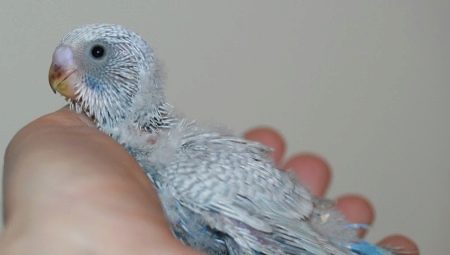
In the wild, birds breed year-round in tree hollows, where they independently take care of their offspring. In captivity, birds need help. Consider in the article the features of caring for budgerigar chicks.
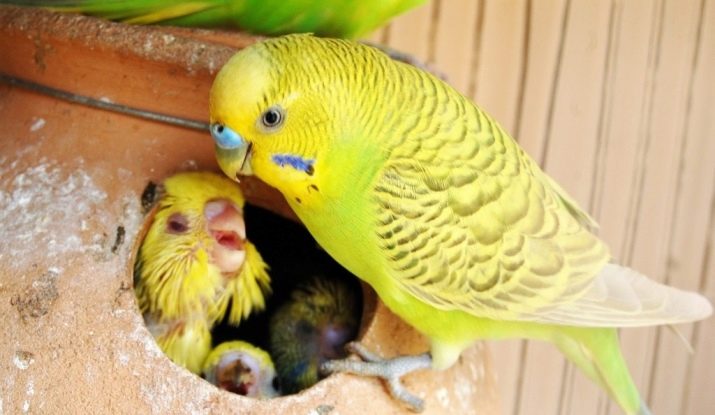
Incubation and birth
The female budgerigars begin to prepare for the chicks in advance. At this moment, they begin to equip a house for their future children, and they do it exclusively to their taste, using for this everything that they find useful: cotton wool, foam rubber, pieces of fabric, branches, paper and small household items. As soon as all design decisions take on a finished look, males and females begin a period of "mating games".
Usually birds are mated after they reach one and a half years, if you do this earlier, the cubs are born prematurely and sick, and stillbirth is not excluded. As a rule, the first egg is laid 16-20 days after the appearance of the nest, as soon as the bird lays the second, the female begins to incubate them. The number of eggs in a clutch varies from 4 to 12, they appear with a difference of 1.5 - 2 days.


The first parrot hatches on days 18-21, all the rest are removed from the shell with the same time difference as the eggs were laid.
As a rule, 10-13 days pass between the appearance of the first and last chick, but if there were a lot of eggs, then the whole process will take a little longer.

To hatch the chick is forced to break through the shell from the inside with the help of a special egg goiter - it is located in the upper part of the mother's beak.This is a rather laborious activity, therefore, only those chicks who have fully formed inside their shelter and have the necessary strength, health and strength can do it. If such an occupation is not within the power of the chicks, then the mother always comes to the rescue - she quickly breaks through the shell with the pinpoint blows of her strong beak.
Usually, the female uses the shell for food, it serves as a good source of calcium and contributes to the early recovery of the young mother's body - after all, all the days preceding the birth of the cubs, she led a rather passive lifestyle, absenting exclusively to eat and drink no more than twice a day.
To help mother and baby to be born, the owners of parrots must maintain a favorable microclimate in the nest. If the air is too dry, the inner film under the shell will wrap the chick and simply stick to it, which will inevitably lead to death. At the time of incubation, the humidity parameter near the "house" should be 60-65%, it is advisable to turn on a humidifier, indoor fountain from time to time, or simply place a vessel with water nearby.
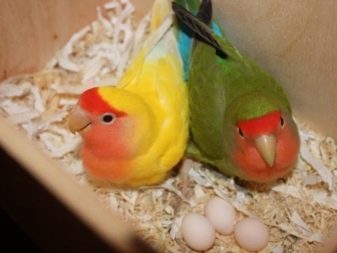

What do newborns look like?
Those breeders of parrots who believe that newborn birds look touching and affectionate are usually very disappointed - the sight that appears to their eyes after the chick hatches cannot be classified as attractive.
At this moment, it is impossible even to imagine that in some 3-4 weeks the cub will become a beautiful exotic bird with bright plumage. The weight of a newborn parrot is only 1 gram, some species of parrots have red eyes. After 3 days, the body weight increases 3-5 times, the young bird is gaining weight rapidly, therefore by the end of the first month it already does not differ in size from its parents in size.

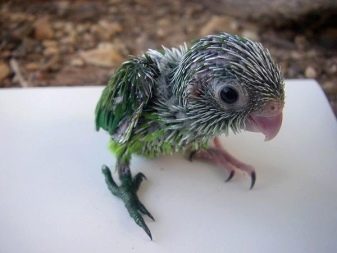
Birds are born almost completely naked, only a weak down is present on the back.
After hatching, the chicks are blind and absolutely helpless, they have a disproportionately large head, an elongated neck and thin weak legs - this physiology makes it impossible for the chicks to move, and they spend the first day only lying down.
Let's take a look at what the development of chicks looks like by day.
- On the 6th day, the egg-shaped goiter disappears, immediately after that the chick becomes able to raise its head, the neck muscles gradually get stronger, and the baby can already hold the head in weight.
- Week-old cubs make attempts to sit up and begin to open their eyes, and on day 10 their gaze becomes meaningful.
- After 12-14 days, the first feathers gradually grow, first on the wings and in the occipital region. At the end of the third week, the plumage is finally formed, and the coloring is established, the tail grows, lengthens and the terry feathers bloom. At the same time, you can determine the sex of the chick. By the end of the first month, feathers completely cover the body of a young bird.
- After about 40 days, the parrot makes its first attempts to fly.
We can safely say that it is in the first days of their life that parrot chicks develop especially rapidly, therefore, these days you need to make every effort to help kids create the foundation for full development.
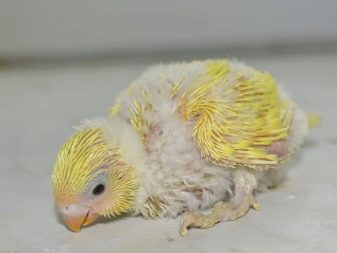

Care
In caring for newborn budgies, the female undoubtedly plays the main role. At this moment, she selflessly protects and protects each of her chicks, regardless of how many of them are and what their state of health is. At this point, special attention is required from the bird breeder - he must look after his pets with redoubled care, providing mother and father with a balanced diet, vitamin and mineral supplements, maintaining ideal cleanliness and comfort of the home, as well as silence and comfortable conditions for the existence of chicks in captivity.
Do not forget that not only the newly-made parents bear the burden of responsibility for the health of their babies, but also their owners.
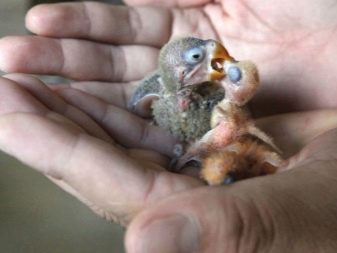

Feeding
For the full development of young parrots, they first of all require healthy and nutrient-rich food. In the first hours after birth, the baby feeds on his mother's goiter milk - it is a complex of special mucous secretions with the inclusion of undigested pieces of food, enriched with useful micro and macro elements.
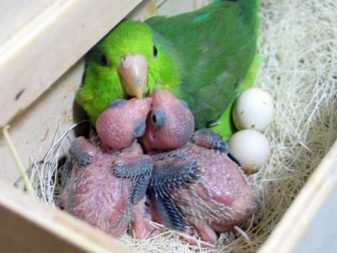
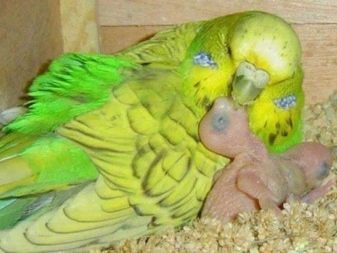
Gradually, the food is replaced with a coarser one, and by 5-6 days the female already feeds her cubs with undigested grain, which she stores in advance in her goiter. The parrot-father also participates in restocking and, along with the female, collects provisions in case there is not enough maternal food for all the babies.
In some situations, you have to resort to artificial feeding, this happens if the parents, for some reason, are unable or simply do not want to take care of their offspring:
- when showing aggression towards newborn parrots;
- if the brood is too large;
- when chicks cannot eat on their own or if they have no appetite;
- in cases when the female is preparing for a new clutch;
- at the death of one or both parents.
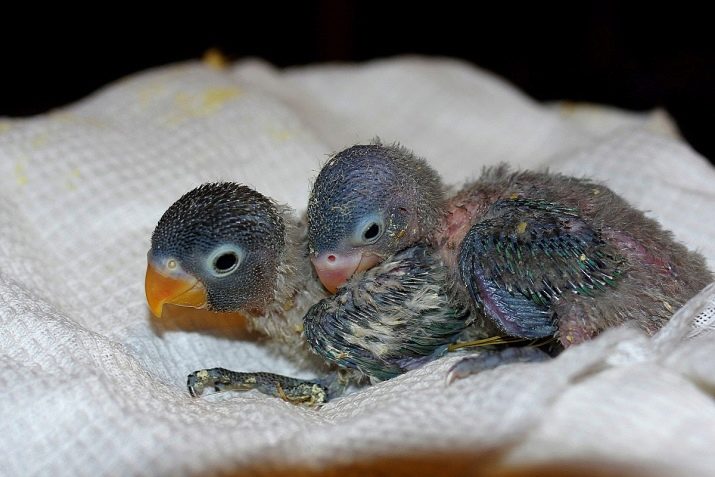
To understand when the participation of the owners is required, you should constantly monitor the life in the nest. If a problem is found, you can try to transfer the chick to another pair, if there is none, then try to plant the female and give the baby to the care of the father.
If neither one nor the other is possible, then you will have to feed the chick artificially, for this they use:
- specialized mixtures for chicks;
- boiled oatmeal or buckwheat porridge with the addition of a few drops of carrot or beetroot juice:
- concentrated broth of oats;
- well-refined germinated grain malt mixed with chopped boiled egg.


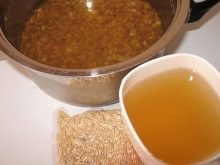
Hungry chicks usually emit a loud, sharp squeak - in this way they signal the start of feeding, you will have to be patient, as this situation will repeat every 2 hours during daylight hours and every 4 hours at night.
To feed a parrot, you need a syringe with an elastic rubber tube or a thin brush - and in both cases, feeding is done directly into the crop.
Feeding the female
The mother of the chicks needs good nutrition - the health and full development of the babies directly depends on the state of the mother and the well-being of the father. In the female's diet, in addition to the grain mixture, mineral supplements must be present, as well as juicy greens, chopped vegetables, cereals and sprouted cereals.
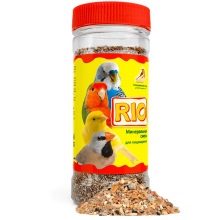
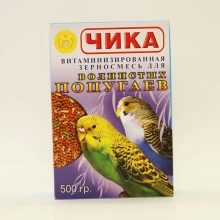
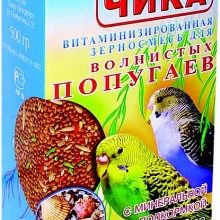
Maintaining a microclimate
Comfortable living conditions in the first days of life are important for the further growth of chicks. It is important that the air temperature near the nest is +36 degrees Celsius, and after a week you can reduce the temperature background to +30.33 degrees. After 3 weeks, the heating is stopped, from this moment the chicks are quite comfortable at a normal room temperature of +22.24 degrees.
By the way, the stores offer a wide selection of heated nests, such an acquisition will be very convenient for both owners and young birds.
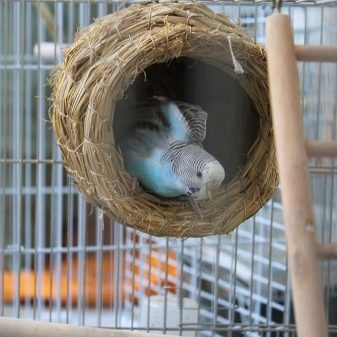
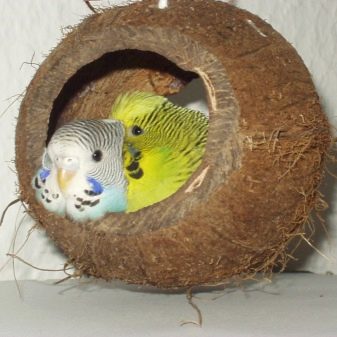
Hygiene
The cage of any bird should be clean, and the feeders and drinkers should be practically sterile. After the birth of the baby, this rule does not change, but the nest itself can be cleaned 2 weeks after the bird hatches. To do this, it is thoroughly cleaned of all accumulated debris and adhering dirt - at this moment, newborn parrots are moved into a specially prepared box with insulation. Please be aware that it is necessary to carry out hygienic measures as quickly as possible, otherwise hypothermia of the chicks is possible.
Be sure to ensure that food fragments and dirt do not remain on the chicks' legs - in this case, there is a high risk of deformation as they grow.If you need to clean it, you can hold the paws a little in a bath with warm water and carefully remove all excess with a cotton swab.
Development
By the month of the month, the bird already resembles an adult in all its appearance, only an uncertain gait and an inept flight gives out a very young chick in it.

After 40 days, the bird begins to fly on its own, and after another 14-20 days, the matured parrot can be removed from adult birds and placed in another aviary. This is very important, because if the chick lives with its parents, then it will not attempt to pilot itself, while being in a separate cage accelerates flying skills without parental support.
For information on how to feed a budgerigar chick, see the next video.








